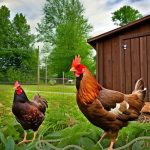Raising pigs and chickens together on farms or homesteads has been a long-standing practice with numerous benefits. This combination creates a symbiotic relationship that can enhance overall farm productivity and sustainability. Pigs, being natural foragers, contribute to soil turnover, while chickens excel at pest control, helping to keep the pig area free from insects and parasites.
The waste products from both animals can be utilized to benefit each other, promoting a more efficient and sustainable farming system. However, integrating pigs and chickens requires careful consideration and planning. There are potential challenges and specific requirements that must be addressed to ensure the well-being of both species.
This article will provide a comprehensive overview of the benefits, considerations, housing requirements, feeding and care practices, and potential challenges associated with keeping pigs and chickens together. By examining these aspects, farmers and homesteaders can make informed decisions about implementing this farming approach and maximize the advantages of this complementary animal pairing.
Table of Contents
- 1 Benefits of Keeping Pigs and Chickens Together
- 2 Considerations for Keeping Pigs and Chickens Together
- 3 Housing Requirements for Pigs and Chickens
- 4 Feeding and Care for Pigs and Chickens
- 5 Potential Challenges of Keeping Pigs and Chickens Together
- 6 Conclusion and Final Considerations for Keeping Pigs and Chickens Together
- 7 FAQs
- 7.1 Can pigs and chickens be kept together?
- 7.2 What precautions should be taken when keeping pigs and chickens together?
- 7.3 Are there any benefits to keeping pigs and chickens together?
- 7.4 Are there any risks to keeping pigs and chickens together?
- 7.5 What should be considered before keeping pigs and chickens together?
Key Takeaways
- Keeping pigs and chickens together can be a beneficial and sustainable practice for small-scale farmers and homesteaders.
- Benefits of keeping pigs and chickens together include waste management, pest control, and complementary diets.
- Considerations for keeping pigs and chickens together include potential health risks, space requirements, and social dynamics between the two species.
- Housing requirements for pigs and chickens should prioritize separate living spaces to prevent aggression and disease transmission.
- Feeding and care for pigs and chickens should be carefully managed to ensure both species receive appropriate nutrition and are kept healthy.
- Potential challenges of keeping pigs and chickens together include territorial behavior, competition for food, and the risk of disease transmission.
- In conclusion, keeping pigs and chickens together can be a rewarding and sustainable practice, but it requires careful planning, management, and consideration of the needs of both species.
Benefits of Keeping Pigs and Chickens Together
Benefits of a Symbiotic Relationship
One of the primary advantages of keeping pigs and chickens together on a farm or homestead is the symbiotic relationship between the two species. Pigs, being natural foragers, can help turn over soil, creating new areas for chickens to forage and scratch. In return, chickens excel at pest control, keeping the pig area clean of insects and parasites. This mutualistic relationship fosters a more balanced and healthy environment for both animals.
Efficient Use of Waste Products
The waste products of each animal can be utilized to benefit the other. For instance, pig manure can be used to fertilize the soil in chicken foraging areas, while chicken manure can be used to fertilize areas where pigs are raised. This creates a more sustainable and efficient farming system, as the waste products of one animal are used to benefit the other.
Maximizing Space and Resources
Raising pigs and chickens together can also help maximize the use of space on a farm or homestead. Both animals can be raised in the same general area, reducing the need for separate housing and infrastructure. This not only saves resources but also promotes a more harmonious and productive farming environment.
Considerations for Keeping Pigs and Chickens Together

While there are many benefits to keeping pigs and chickens together, there are also important considerations to keep in mind. One consideration is the potential for aggression between pigs and chickens. Pigs can be aggressive towards chickens, especially if they feel threatened or if there is competition for food.
It is important to provide separate feeding areas for pigs and chickens to reduce the risk of aggression. Additionally, it is important to consider the potential for disease transmission between pigs and chickens. Pigs and chickens can both carry diseases that can be harmful to the other species, so it is important to practice good biosecurity measures to reduce the risk of disease transmission.
Another consideration is the potential for damage to pasture or foraging areas. Pigs are natural rooters and can cause damage to pasture or foraging areas if not managed properly. It is important to rotate animals through different areas to prevent overgrazing and damage to the land.
Housing Requirements for Pigs and Chickens
When keeping pigs and chickens together, it is important to provide appropriate housing for both species. For pigs, it is important to provide a secure and sturdy shelter that protects them from the elements and provides adequate space for them to move around. Pigs also require access to a wallow or mud hole, as they do not have sweat glands and need to cool off in hot weather.
For chickens, it is important to provide a secure coop that protects them from predators and provides adequate space for roosting and nesting. The coop should also have good ventilation and natural light to promote healthy living conditions for the chickens. When designing housing for pigs and chickens, it is important to consider the potential for aggression between the two species.
Separate feeding areas should be provided to reduce the risk of aggression, and it may be necessary to provide separate housing areas if aggression becomes a significant issue.
Feeding and Care for Pigs and Chickens
Feeding and care for pigs and chickens require careful consideration when keeping them together. Pigs are omnivores and require a balanced diet that includes grains, protein sources, fruits, vegetables, and forage. It is important to provide a high-quality feed that meets the nutritional needs of pigs, as well as access to fresh water at all times.
Additionally, pigs require regular health checks and vaccinations to prevent disease and maintain their overall well-being. For chickens, it is important to provide a balanced diet that includes a high-quality feed, as well as access to fresh water at all times. Chickens also require access to grit for digestion and calcium supplements for egg production.
Regular health checks and vaccinations are also important for maintaining the health of chickens. When keeping pigs and chickens together, it is important to provide separate feeding areas to reduce the risk of aggression between the two species.
Potential Challenges of Keeping Pigs and Chickens Together

Risk of Disease Transmission
When raising pigs and chickens together, one of the primary concerns is the risk of disease transmission between the two species. Both pigs and chickens can carry diseases that can be harmful to each other, making it essential to implement good biosecurity measures to minimize the risk of disease transmission.
Risk of Aggression
Another potential challenge of keeping pigs and chickens together is the risk of aggression between the two species. Pigs can be aggressive towards chickens, especially if they feel threatened or if there is competition for food. To mitigate this risk, it is crucial to provide separate feeding areas for pigs and chickens.
Managing Pasture and Foraging Areas
It is also important to consider the potential for damage to pasture or foraging areas when keeping pigs and chickens together. As natural rooters, pigs can cause significant damage to pasture or foraging areas if not managed properly. To prevent overgrazing and damage to the land, it is essential to rotate animals through different areas.
Conclusion and Final Considerations for Keeping Pigs and Chickens Together
In conclusion, keeping pigs and chickens together on a farm or homestead can be a beneficial and symbiotic relationship that offers numerous advantages. The mutualistic relationship between pigs and chickens can help create a more balanced and healthy environment for both animals, while also maximizing the use of space on a farm or homestead. However, there are important considerations and potential challenges that must be taken into account when deciding to keep pigs and chickens together.
It is crucial to provide appropriate housing, feeding, care, and biosecurity measures to ensure the well-being of both species and reduce the risk of disease transmission or aggression. By carefully considering these factors, farmers and homesteaders can successfully keep pigs and chickens together while reaping the many benefits of this symbiotic relationship.
If you’re considering keeping pigs with chickens, you may also be interested in learning about the benefits of renting a chicken coop. Renting a chicken coop can be a convenient and cost-effective way to start your own flock of chickens without the commitment of building or buying a permanent coop. This article provides valuable information on the advantages of renting a coop and how it can be a great option for those interested in raising chickens.
FAQs
Can pigs and chickens be kept together?
Yes, pigs and chickens can be kept together in the same area, as long as proper precautions are taken to ensure the safety and well-being of both animals.
What precautions should be taken when keeping pigs and chickens together?
It is important to provide separate living spaces for pigs and chickens to prevent any potential conflicts or injuries. Additionally, proper fencing and housing should be in place to keep the animals separated when necessary.
Are there any benefits to keeping pigs and chickens together?
Keeping pigs and chickens together can have benefits such as waste management, as pigs can help to consume food scraps and chicken waste, while chickens can help to control pests in the pig’s environment.
Are there any risks to keeping pigs and chickens together?
There are potential risks to keeping pigs and chickens together, such as the spread of diseases between the two species. It is important to monitor the health of both animals and practice good hygiene to minimize these risks.
What should be considered before keeping pigs and chickens together?
Before keeping pigs and chickens together, it is important to consider the space and resources available, as well as the specific needs and behaviors of each animal. Proper planning and management are essential for successful cohabitation.
Meet Walter, the feathered-friend fanatic of Florida! Nestled in the sunshine state, Walter struts through life with his feathered companions, clucking his way to happiness. With a coop that’s fancier than a five-star hotel, he’s the Don Juan of the chicken world. When he’s not teaching his hens to do the cha-cha, you’ll find him in a heated debate with his prized rooster, Sir Clucks-a-Lot. Walter’s poultry passion is no yolk; he’s the sunny-side-up guy you never knew you needed in your flock of friends!








